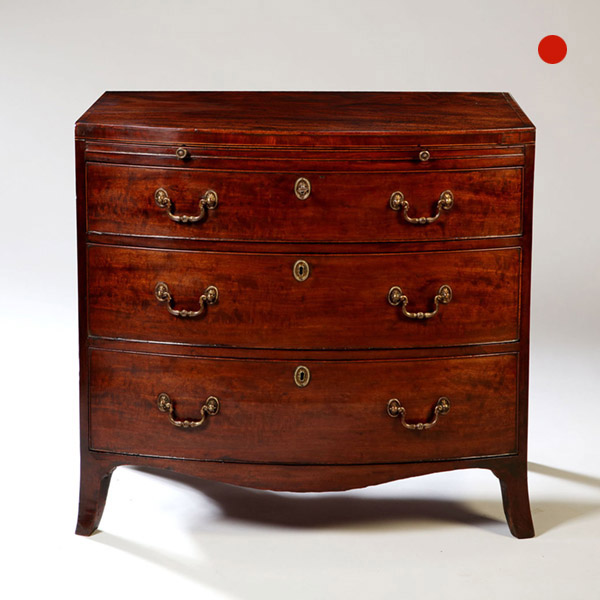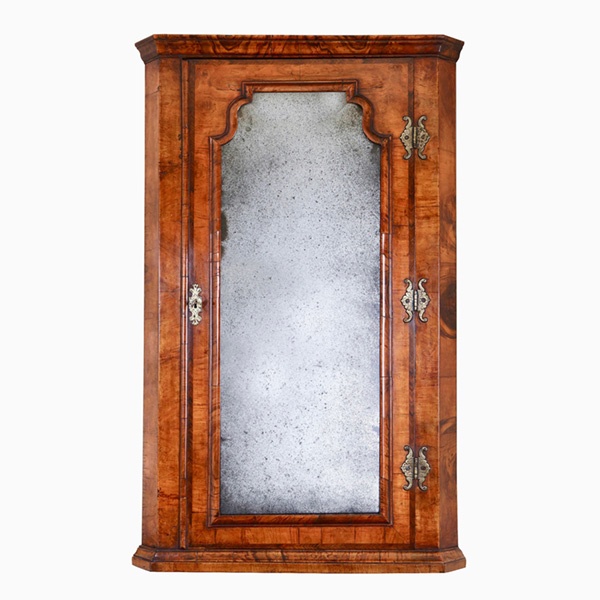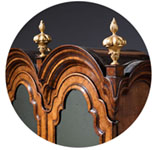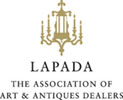An extremely fine and rare early George III mahogany supper table plausibly by Thomas Chippendale
Sold
Request Information
Follow Us
An extremely fine and rare early George III mahogany supper table plausibly by Thomas Chippendale
An extremely fine and rare early George III mahogany supper table plausibly by the most celebrated maker of English furniture, Thomas Chippendale.
On the 5 May 1759, a notably similar table in form was supplied to Dumfries house by Thomas Chippendale “A mahog: breakfast table of fine wood wt. a Writing drawer and wirework round and castors….. £6-8”.
Though the example here shares many of the same attributes, the leather-wrapped low castors, fine moulding below the super compartment and fiddle back concave doors, it exceeds in many ways. The finely moulded solid mahogany top is decorated with an exquisite parquetry star to its centre oval of flame mahogany and further banded in box, quartered and edged in double-lined box and tulip cross banding. Similarly, the leaves are also of solid mahogany and veneered in a similar fashion. The solid mahogany moulded legs are relived to the internal edge, chamfered and inlaid to the face with 45 degrees cut tulip. Above the fine concave doors and moulded, gilt-brass wire supper section sits the writing drawer, decorated in fine cuts of mahogany with a line inlay of box and banded in tulip. The reverse is decorated in much the same fashion with a dummy drawer.
Condition
Good. Wear consistent with age and use.
Dimensions
Height: 72 in. (182.88 cm)
Width: 56 in. (142.24 cm)
Depth: 66 in. (167.64 cm)
Literature
The Life and Works of Thomas Chippendale by Christopher Gilbert, p 219, plate 399-400.
The Gentleman’s Director, No. LII ‘Breakfast Tables’
Attributed to
Thomas Chippendale
PREVIOUSLY SOLD

George III Sheraton period bow-fronted caddy topped mahogany chest of drawers
A fine George III Sheraton period bow-fronted mahogany chest of drawers with brushing slide. The chest has the perfect time aged colour to its original wax finished surface and has truly commendable proportions. I love everything about this outstanding and original piece.

George III Sheraton period bow-fronted caddy topped mahogany chest of drawers
A fine George III Sheraton period bow-fronted mahogany chest of drawers with brushing slide. The chest has the perfect time aged colour to its original wax finished surface and has truly commendable proportions. I love everything about this outstanding and original piece.
YOU MAY ALSO LIKE

Queen Anne Walnut Corner Cupboard with Bevelled Mirror Plate
A truly remarkable find in original condition. To the door a shaped soft bevelled mirror plate is framed by a cross-grain molding of typical queen Anne design which is further cross-banded, feather-banded and edged to the opening with a single de-molding.

Queen Anne Walnut Corner Cupboard with Bevelled Mirror Plate
A truly remarkable find in original condition. To the door a shaped soft bevelled mirror plate is framed by a cross-grain molding of typical queen Anne design which is further cross-banded, feather-banded and edged to the opening with a single de-molding.


















